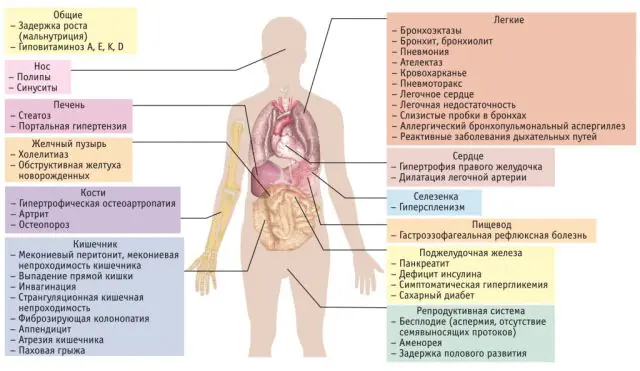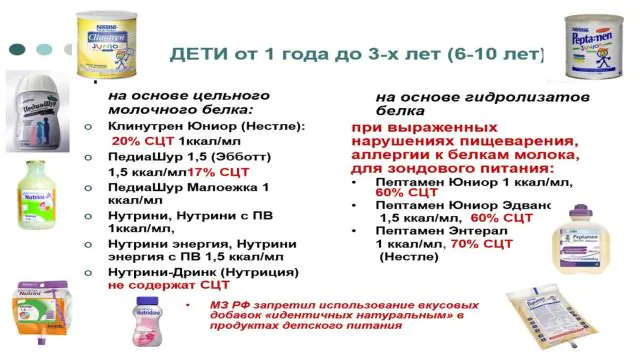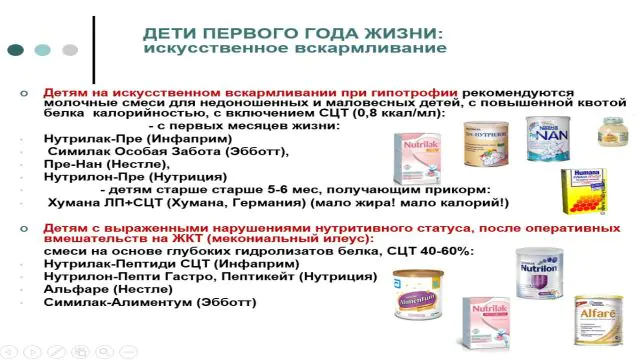
What is cystic fibrosis, causes of development. Symptoms, diagnostic methods. Treatment and methods of preventing the disease in adults and children.
The content of the article:- What is cystic fibrosis
- Main symptoms
- Treatment options
- Medicines
- Folk remedies
- Diet
Cystic fibrosis is a systemic hereditary pathology caused by genetic mutations that leads to severe damage to the respiratory system. Occurs in one out of 10 thousand newborns. With cystic fibrosis, tissue damage is observed and the secretory activity of the endocrine glands is disrupted. The disease spreads to the pancreas, sweat glands, and affects the intestines and gastrointestinal tract. Such disturbances occur during the process of intrauterine development.
Cystic fibrosis - what is this disease?

Cystic fibrosis is a genetic disease caused by mutations in the genes of proteins that are responsible for transporting elements such as chlorine and sodium through the cellular epithelium. The disease affects the lungs, damages small and large airways, and leads to chronic recurrent bacterial infections.
Cystic fibrosis is often diagnosed in adults, since in childhood the genetic mutation is disguised as other disorders of the respiratory system and gastrointestinal tract.
The prognosis depends on the degree of damage to the respiratory organs, in particular the lungs. More favorable for patients whose pancreatic function is not impaired.

A serious consequence of such a genetic mutation is pancreatic dysfunction and impaired absorption of vitamins and nutrients. From the moment of diagnosis, measures must be taken to sanitize the airways. Regular aerobic exercises, breathing exercises (pranayama), and yoga are suitable for this.
Cystic fibrosis can be complicated by sinusitis, pleurisy, pulmonary hemorrhage, and intestinal bleeding. In some cases, celiac disease (gluten intolerance), edema syndrome, urolithiasis, pyelonephritis, intestinal obstruction, and rectal prolapse develop.
Cystic fibrosis is a hereditary disease caused by mutations of certain genes.
If there is only one mutated chromosome in the 7th pair of chromosomes, then a person may not get sick, but will pass on such a “breakage” to future generations. If both parents have the mutation, this is the main cause of cystic fibrosis.
The leading factors in which the pathological process progresses: damage to the endocrine glands, pathological changes in connective tissues, disturbances in water-electrolyte metabolism.
Main symptoms of cystic fibrosis

Symptoms of cystic fibrosis are associated with the formation of a viscous, thick secretion in the lungs, which provokes blockage of bronchioles and the development of pulmonary failure. Cystic fibrosis in children with the pulmonary form of the disease manifests itself in the form of a constant cough, susceptibility to regular bronchitis and pneumonia. The skin is pale, has a gray tint, and blue discoloration of the fingertips, lips, and earlobes is observed. A constant lack of oxygen leads to developmental delays and lack of energy.
Important! 1/4 of newborn babies with cystic fibrosis experience intestinal obstruction: a viscous secretion clogs the intestinal lumen. At the same time, children are often restless, with a bloated belly, pale skin, and frequent regurgitation.
If mucus accumulates in the area of the pancreas, this leads to the fact that enzyme substances cannot enter the intestines due to the fact that the ducts of the gland are blocked from birth. There is a gradual destruction of the pancreas' own tissues, cysts and scar tissue form. The stomach cannot digest proteins and fats. The processes of rotting and fermentation develop, and complaints of increased gas formation arise. Main symptoms: constant bloating, regular passage of gas, bowel movements several times a day with an unpleasant odor, dry mouth due to insufficient saliva, difficulty in eating dry food.
The mixed form of cystic fibrosis manifests itself with alarming symptoms from both the respiratory system and the gastrointestinal tract. This is the most severe and unfavorable course of the disease. The erased form is accompanied by frequent sinusitis, recurrent bronchitis, and liver cirrhosis.
The main clinical manifestations that people pay attention to when diagnosing cystic fibrosis are:
- In infancy. Regular episodes of coughing and shortness of breath, a tendency to frequent pneumonia, diarrhea, rectal prolapse, swelling, delayed physical development, feces with an oily, unformed structure and a sharp, unpleasant odor. The skin takes on a salty taste, regardless of whether the child sweats or not.
- In preschool age. The development of persistent, incessant cough, sputum with or without purulent impurities is observed. Other signs of cystic fibrosis: the child lags behind in growth and development compared to his peers, fingers are deformed (like “drumsticks”), the rectum prolapses, and chronic diarrhea is observed. Shortness of breath worries regularly, even if the child has not been physically active. There is an increase and impaired functioning of the liver.
- During adolescence. Tendency to form polyps in the respiratory system, recurrent sinusitis, bronchospasms, pancreatitis. The first signs of diabetes mellitus are observed (in laboratory blood tests, as well as increased sweating, thirst, hunger), and breathing is impaired.
If the doctor suspects a genetic “damage,” they prescribe a special DNA test for cystic fibrosis (blood test) that detects mutations, and ask them to take a lengthy questionnaire. Carefully collect anamnesis, including family history. The patient’s nationality, gender, and family history of infant death in the first year of life are of key importance. The decision on how to treat cystic fibrosis is made by the doctor according to the diagnostic results obtained.
Newborn babies are prescribed laboratory diagnostics to check for immunoreactive trypsin in the blood. If this pancreatic enzyme is increased, it may indirectly indicate cystic fibrosis. An X-ray of the lungs is also prescribed, and stool is examined (a coprogram is performed).
Treatment options for cystic fibrosis
Cystic fibrosis is a genetic disease, so therapy targeting the underlying cause is difficult in modern medicine. Doctors give the following recommendations for cystic fibrosis: to make patients feel better, they use medications to relieve symptoms, traditional medicine, and follow a diet. The patient is recommended to take mucolytics, which thin the sputum, antibiotics, and anti-inflammatory treatment.
Medicines for cystic fibrosis

The doctor selects the medications, taking into account the clinical manifestations and the results of complex diagnostics. The general treatment regimen for cystic fibrosis is as follows:
- ACC. A secretolytic that stimulates respiratory tract motility. The drug based on acetylcysteine is available in the form of soluble tablets, syrup and powder for internal use. The medicine facilitates the passage and removal of secretions and exhibits antioxidant properties. Tablets, powder and syrup are recommended to be used after the main meal. During therapy, maintain a drinking regime to speed up the removal of sputum. Patients with cystic fibrosis are advised to consume 800 mg of the active substance per day. In case of overdose, there is a possibility of developing nausea, vomiting, increased sputum secretion, abdominal pain, and heartburn. The cost of the drug is 240 rubles. (93 UAH). Analogs: Asibrox, Atete, Atsestad, Acetal.
- Micrasim. Enzyme preparation based on pancreatin, lipase, amylase, protease. Active substances facilitate the digestion of proteins, fats, and carbohydrates. Available in capsule form for internal use. The capsule shell dissolves under the influence of gastric juice, after which the active substances begin to be gradually released. Enzymes are evenly mixed with food in the gastrointestinal tract, the maximum therapeutic effect is observed half an hour after using the medicine. In the treatment of cystic fibrosis, Mikrasim allows you to compensate for existing enzyme deficiency. Adults take the capsules whole. When treating children, the capsule can be opened and the contents mixed with food at room temperature. The drug is not recommended for patients with individual intolerance to active substances, as well as for exacerbation of acute or chronic pancreatitis. The price is 1400 rubles. (550 UAH). Analogues: Adzhizim, Zentaze, Eurobiol.
- Ciprofloxacin. An antibacterial drug that is used in the treatment of infectious complications of cystic fibrosis. Active against gram-positive and gram-negative microorganisms. Shows bactericidal and antibacterial properties. It is not recommended to combine with medications that contain theophylline. The price is 50 rubles. (20 UAH). Analogues: Tsipromed, Tsifran, Tsiloxan, Tsiprodox, Tsiproxil.
The dosage, frequency and duration of use of medications is determined by the doctor, taking into account the patient’s age, the form of cystic fibrosis, the individual characteristics of the body, and the presence of concomitant disorders.
Folk remedies for cystic fibrosis

Alternative treatment for cystic fibrosis does not guarantee a complete cure and is used as an addition to the basic therapy regimen.
Effective folk remedies:
- To liquefy sputum, use thermopsis, thyme, licorice roots, and marshmallow. All components are mixed, poured with boiling water and left in a thermos for 3-4 hours. Take 1/2 glass twice a day after meals. If the active ingredients are well tolerated, long-term use is possible. The herbal collection can also be used to prepare a solution for inhalation.
- To ensure a sufficient supply of vitamin C, it is recommended to consume rosehip decoction. The plant is washed, crushed, poured with boiling water and left for 40 minutes. Drink 1 glass per day. You can add a small amount of light honey to the chilled drink.
- To reduce pain in the gastrointestinal tract, use natural antispasmodics: mint, belladonna, calendula, oregano. Plants not only reduce spasms, their action is also aimed at preventing the addition of a bacterial infection. The herbal collection is used to prepare decoctions and infusions.
- To have a beneficial effect on the functioning of the pancreas, use a mixture of elecampane and wheatgrass.
- To have a beneficial effect on the immune system and slow down the progression of the pathological process, use a mixture that includes linden, lemon balm, echinacea, and mint. All components are mixed in equal parts, poured with water and boiled in a water bath for 15 minutes. Then remove the drink from the heat, infuse and cool, take 0.5-1 glass at night. This remedy also helps cope with psycho-emotional stress and eliminates sleep disturbances.
- For cystic fibrosis of the lungs, a decoction based on pear branches is used. The raw materials are crushed, filled with water and boiled over low heat. This is a healthy and tasty vitamin drink that can be given even to a small child.
- For cystic fibrosis of the intestines, it is useful to take herbal tea based on yarrow leaves. A tablespoon of dried raw material is poured with boiling water and left for 40 minutes. Take 0.5 cups 2-3 times a day. People with bleeding disorders should take particular care when using yarrow.
Diet for cystic fibrosis

Food for cystic fibrosis should be high in calories, and the diet must be combined with the use of enzyme medications that normalize digestion. Coarse fiber is removed from the diet, and food must be added with salt. If the patient does not receive enough necessary nutrients, it is necessary to identify existing deficiencies and replenish them with the help of supplements.


Pictured is nutrition for children with cystic fibrosis
To alleviate the clinical picture of cystic fibrosis, you should adhere to a number of nutritional recommendations:
- The diet should be high-calorie and nutritious, high in protein and fat, to ensure optimal supply of vitamins, microelements, and amino acids.
- It is necessary to remove from the diet foods that provoke increased mucus production: dairy and fermented milk foods, bananas, gluten, simple carbohydrates.
- To prevent the development of diabetes mellitus, which is often caused by pancreatic insufficiency, you should eat 2-3 times a day, avoiding frequent, small meals, snacks, and bite-sized meals.
- If you have cystic fibrosis, you need to follow a drinking regime to facilitate the removal of sputum. The optimal amount of fluid per day is calculated using the formula: 30 ml of water multiplied by body weight.
- As part of the treatment of the disease, it is recommended to use natural probiotics, which restore the natural microflora and facilitate the digestion process. Fermented foods are introduced into the diet: sauerkraut and cucumbers, pickled apples, homemade kvass.
- Eat enough fiber from fresh foods: seasonal leafy greens, vegetables, fruits, berries. Products with bright skins are especially beneficial.
Today, cystic fibrosis is a difficult-to-treat genetic mutation that affects not only the respiratory system and gastrointestinal tract, but subsequently the entire body as a whole. To prevent development, it is recommended to consult a geneticist when planning a child. Both parents must undergo the examination.
What is cystic fibrosis - watch the video:



